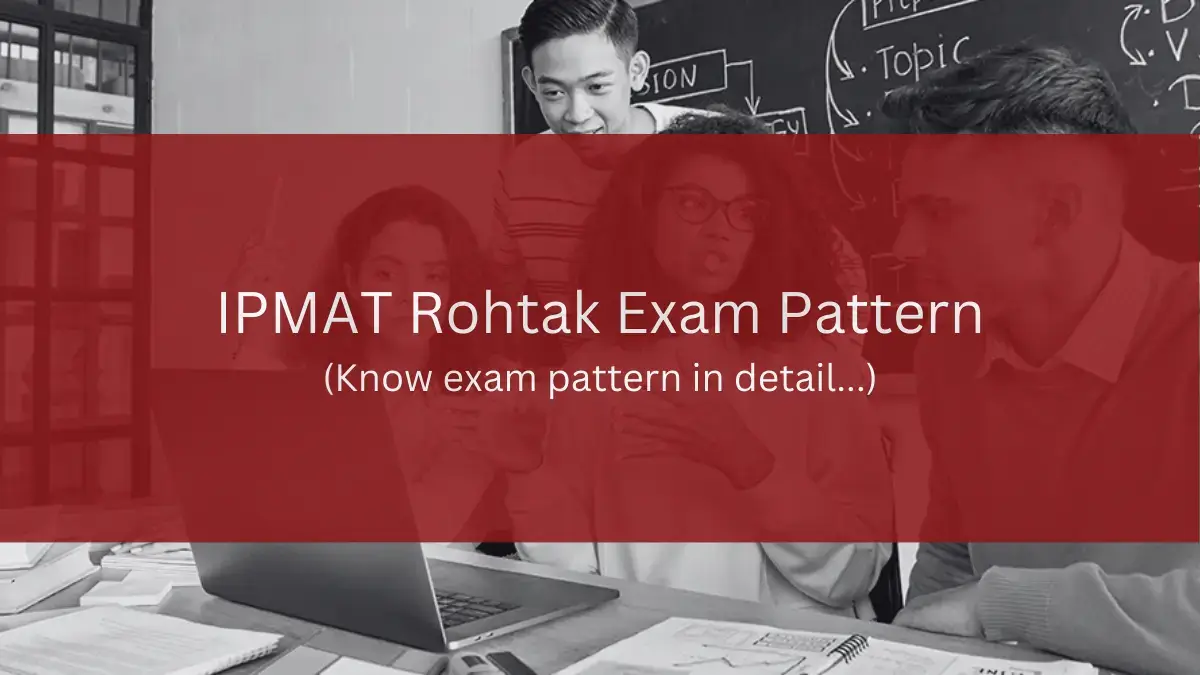IPMAT Rohtak Exam Pattern 2025: Know All About Exam Pattern
Summary: For your aspiration to reach your aimed Institution, understanding the IPMAT Rohtak exam pattern 2025 is necessary to precisely understand the weightage and clearly figure out the time limits for each section. Familiarising oneself with the structure, question types, and time allocation will allow you to develop a strategic preparation, enabling candidates to optimise their performance on exam day.

With the correct details about the paper pattern, applicants can modify their study plans, focus on key areas, and effectively manage time during the test. This knowledge not only boosts confidence but also increases the likelihood of achieving desired scores, ultimately paving the way for admission to a prestigious management programme.
IPMAT Rohtak Exam Pattern 2025
The Indian Institute of Management, Rohtak, is responsible for prescribing the IPMAT Rohtak exam pattern for the exam.
IIM Rohtak IPM Aptitude Test 2025:
- The IPMAT Exam is conducted to assess your abilities in various areas, including mathematics, logical reasoning, and proficiency in the English language. The test will evaluate your potential to solve problems and think critically, as well as your command of the language.
- The IPMAT Rohtak question paper will have 120 questions. Each question carries a weightage of 4 marks, so candidates must practise accordingly.
- Also, do not forget that one mark will be deducted from your score for each question that you answer incorrectly. So be careful of this marking, and look forward to the preparation!
- Questions that will appear in the exam will be multiple-choice questions.
- In the duration of your 2-hour exam, there is no specific time limit for each section. You can go to any section you prefer. Note that unlike IIM Indore, there is no restriction on the time allocated to each section.
Candidates must review the IPMAT Rohtak 2025 Exam pattern to understand better the exam structure from the table given below:
| Section | Number of questions | Duration |
| Quantitative Ability | 40 | 40 mins |
| Logical Reasoning | 40 | 40 mins |
| Verbal Ability | 40 | 40 mins |
| Total | 120 | 120 mins |
Read More: IPMAT Rohtak Admit Card
To be selected for the personal interview, applicants need to score above the IPMAT Cutoff.
During an interview, the interviewer evaluates your academic background, general knowledge, and ability to communicate effectively.
Stay updated and be faithful to your preparation plan for the IPMAT Rohtak success journey!
IPMAT Rohtak Exam Pattern 2025: Marking Scheme
According to the IPMAT Paper Pattern, you will receive four marks for each correct answer, and one mark will be deducted for every incorrect answer in all three sections.
If you leave a question unanswered, you will not gain or lose any marks.
Look at the table below:
| Question | Marks |
| Correct Answer | +4 Marks |
| Wrong Answer | -1 Mark |
Read More: IPMAT Rohtak Syllabus
IPMAT Rohtak Result
IPMAT Rohtak Analysis
IPMAT Rohtak Exam Pattern 2025: Key Takeaways
According to the details mentioned above in the article, the following are key takeaways to quickly draw the conclusion and cover important points to remember:
The Integrated Programme in Management Aptitude Test (IPMAT) is a computer-based exam that is conducted online. The total duration of the test is 120 minutes or 2 hours. It is designed to assess the aptitude and skills of candidates who are seeking admission to the management programme at the undergraduate level. The exam consists of multiple-choice questions and covers various sections, including quantitative ability, verbal ability, and logical reasoning.
The examination consists of three sections:
– Quantitative Ability
– Verbal Ability
– Logical Reasoning
– MCQ scoring: +4 marks for correct answers, 1 mark for incorrect answers
The purpose of the exam is to assess your proficiency in critical thinking, language comprehension, and mathematical problem-solving.
Also, Read: https://www.imsindia.com/blog/ipmat/ipmat-rohtak-result/
https://www.imsindia.com/blog/ipmat/ipmat-rohtak-cut-off/
FAQs for IPMAT Rohtak Exam Pattern 2025
- Why is it important to understand the IPMAT Rohtak paper pattern 2025?
Understanding the paper pattern helps one comprehend the weightage of each section and allocate time efficiently for preparation and the exam.
2. Who prescribes the IPMAT Rohtak exam pattern 2025?
The Indian Institute of Management, Rohtak, is responsible for prescribing the exam pattern for the IPMAT exam.
3. What areas does the IPMAT Rohtak Exam assess?
The IPMAT Rohtak Exam assesses candidates’ abilities in mathematics, logical reasoning, and proficiency in the English language, evaluating problem-solving skills and critical thinking.
4. What is the marking scheme for IPMAT Rohtak?
Candidates receive four marks for each correct answer, with one mark deducted for every incorrect answer in all three sections. Unanswered questions do not result in any mark gain or loss.
5. How is the IPMAT Rohtak Exam conducted?
The exam will be in computer mode and online, with a total duration of 120 minutes or 2 hours, consisting of multiple-choice questions covering quantitative ability, verbal ability, and logical reasoning.
6. What sections are included in the IPMAT Rohtak Exam?
The exam comprises three sections: Quantitative Ability, Verbal Ability, and Logical Reasoning. The exam evaluates various skills essential for management programmes at the undergraduate level.
7. What is the significance of scoring above the IPMAT Cutoff?
Candidates must score above the IPMAT Cutoff to be part of the personal interview round, where assessors evaluate their academic background, general knowledge, and communication skills.
8. How should candidates prepare for the IPMAT Rohtak Exam?
Candidates should stay updated and adhere to a faithful preparation plan, focusing on understanding the exam pattern, practising questions, and enhancing quantitative ability, verbal ability, and logical reasoning skills.




